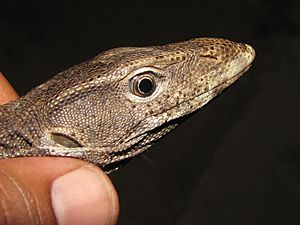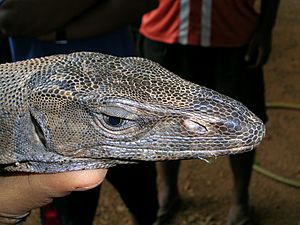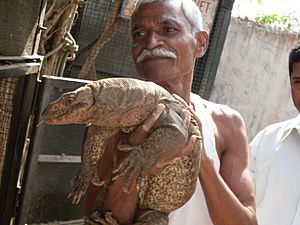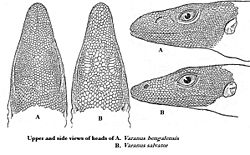Bengal monitor facts for kids
Quick facts for kids Bengal monitor (Indian monitor) |
|
|---|---|
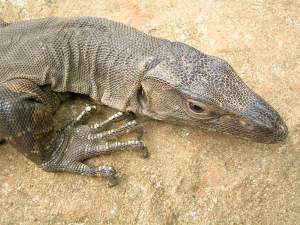 |
|
| Bengal monitor lizard | |
| Conservation status | |
| Scientific classification | |
| Kingdom: | |
| Phylum: | |
| Class: | |
| Order: | |
| Suborder: | |
| Family: | |
| Genus: | |
| Subgenus: |
V. (Empagusia)
|
| Species: |
V. bengalensis
|
| Binomial name | |
| Varanus bengalensis (Daudin, 1802)
|
|
| Synonyms | |
|
Tupinambis bengalensis |
|
The Bengal monitor (Varanus bengalensis), also called the Common Indian Monitor, is a large lizard. You can find it across Bangladesh, India, and Pakistan. These lizards can grow quite big. Their body can be up to 75 centimeters (about 30 inches) long. Their tail adds another 100 centimeters (about 40 inches) to their length. Bengal monitors eat small animals, birds' eggs, insects, and fish.
Contents
What Does a Bengal Monitor Look Like?
Bengal monitors can grow to be very long, sometimes almost 175 centimeters (about 5.7 feet) from nose to tail tip. The body itself, from snout to where the tail begins, can be 75 centimeters. Males are usually bigger and heavier than females. A heavy monitor might weigh around 7.2 kilograms (about 16 pounds).
Young Bengal monitors are much more colorful than adults. They have dark stripes on their neck, throat, and back. Their belly is white with dark stripes and spots of grey or yellow. Young monitors also have yellow spots on their back connected by dark stripes. As they get older, their color changes to light brown or grey. Dark spots then give them a speckled look.
Different Types of Bengal Monitors
There are slight differences in Bengal monitors depending on where they live. For example, those in India and Sri Lanka look a bit different from those in Myanmar. Scientists used to think they were different species. Now, they are considered two subspecies. One subspecies lives west of Myanmar, and the other, called nebulosus, lives to the east.
Special Features of Their Body
Bengal monitors have special slit-like nostrils located between their eyes and the tip of their snout. They can close these nostrils whenever they want. This helps keep out dirt or water. Their skin has rough patches, and on their sides, they have tiny pits. These pits are more common in males. They might produce a special scent, like a perfume, to communicate.
Like snakes, Bengal monitors have a forked tongue. They stick it out to sense things around them, like smells. Their tongue is not used to help them swallow food. These lizards can store fat in their tails and bodies. This fat helps them survive when food is hard to find.
Their lungs are spongy, which is different from many other lizards. This design helps them breathe more efficiently. It also allows them to be more active. They have teeth that are attached to the inside of their jawbones. New teeth grow in to replace old ones about four times a year. While some monitor lizards have a mild venom, there is no evidence that Bengal monitors are harmful.
Where Do Bengal Monitors Live?
Bengal monitors are found in many places, from Iran all the way to Java. This makes them one of the most widespread monitor lizards. You can find them in river valleys in countries like Iran, Pakistan, Afghanistan, India, Nepal, Sri Lanka, Bangladesh, and Myanmar.
The subspecies Varanus bengalensis nebulosus (the clouded monitor) lives in southern Myanmar, Vietnam, Cambodia, Thailand, Malaysia, Sumatra, Java, and the Sunda Islands. They usually live in lower areas, from dry desert-like places to moist forests. They are often seen in farms and usually live below 1,500 meters (about 4,900 feet) in altitude.
How Do Bengal Monitors Live?
Bengal monitors usually live alone. They spend most of their time on the ground, but young ones often climb trees. The clouded monitor subspecies is even better at climbing trees. These lizards find shelter in burrows they dig or in cracks in rocks and buildings. Clouded monitors prefer hollows in trees. Both types might also use old termite mounds for shelter.
Bengal monitors are active during the day. They wake up around 6 AM and warm themselves in the morning sun. In colder places, they might hide during winter and slow down their body activities. They don't usually fight over territory. They might move to different areas depending on where they can find food.
They are generally shy and try to avoid people. They have excellent eyesight and can spot a person moving almost 250 meters (about 820 feet) away. If caught, some might bite, but it's rare. Even though they are found on farms, they prefer forests with large trees. Areas with lots of ground cover and big trees are their favorite places. Some Bengal monitors in zoos have lived for almost 22 years. Large predators like pythons, some mammals, and birds hunt adult monitors.
Life Cycle and Reproduction
Female Bengal monitors can store sperm, meaning they can lay fertile eggs even if they haven't been with a male recently. The main time for breeding is from June to September. However, males start showing signs of fighting behavior in April.
Females dig a nest hole in flat ground or a vertical bank. They lay their eggs inside, then cover them up and pat down the soil with their snouts. Females often dig other fake nests nearby to confuse predators. Sometimes, they use a termite mound for their nest. A female usually lays about 20 eggs at once. The eggs hatch after a long time, from 168 to 254 days. About 40% to 80% of the eggs will hatch.
How Do They Move?
Bengal monitors can move very fast on the ground. Smaller ones might climb trees to escape danger, but bigger ones prefer to run away on the ground. They are good climbers. On the ground, they sometimes stand on their back legs to get a better view. Males also stand up when they fight each other. They are also good swimmers and can stay underwater for at least 17 minutes. They use both trees and bushes for shelter.
What Do They Eat?
Bengal monitors are active all day, doing different things, including finding food. Large adults can climb straight up tree trunks. Sometimes, they even sneak up on and catch bats sleeping in trees. Their usual diet includes beetles, grubs, grasshoppers, scorpions, snails, ants, and other small creatures without backbones.
They eat animals with backbones less often. These might include frogs, fish, other lizards, snakes, and small rodents. Bengal monitors also eat dead animals they find. In places where there are farm animals, they often visit animal droppings to look for beetles and other insects.
Bengal Monitors in Culture
This lizard has many different names in local languages. For example, it's called bis-cobra in western India and Thalagoya in Sri Lanka. People in some areas mistakenly believe these harmless lizards are venomous. In Rajasthan, some even think they only become venomous during the rainy season.
Monitor lizards are sometimes hunted. Their body fat, which is taken out by boiling, is used in many traditional remedies. In Sri Lanka, the water monitor is thought to be dangerous, but the Bengal monitor is seen as harmless. The meat of the land monitor is eaten by some local groups, but water monitor meat is not. Killing a land monitor is often seen as a cowardly act in folklore.
A family group in Maharashtra, India, called Ghorpade, says their name comes from a story. A legendary hero named Tanaji Malusare supposedly climbed a fort wall using a monitor lizard and a rope. There are many folk stories about soldiers using monitor lizards to climb fort walls.
The skin from the Bengal monitor's belly has traditionally been used to make the drumhead for the kanjira. This is a type of drum used in South Indian music.
Images for kids
See also
 In Spanish: Varano de Bengala para niños
In Spanish: Varano de Bengala para niños




